New Artistic Surprises in the Streets and Parks of Zagreb
August 21, 2021 - The Zagreb Tourist Board is seeking to connect its inhabitants and visitors with the city through the project ''Around'', and it is thus that from August 20 to 30 they will be able to find new artistic surprises in the streets and parks of the Croatian capital.
As reported by Turističke Priče, this year, in cooperation with the Zagreb Tourist Board, the project "Around" continues with new artistic surprises that beautify the face of the city, create an atmosphere of optimism in these challenging times, and invite citizens to rediscover their city through art. From August 20 to 30, everyone is invited to go on an artistic tour of the city and see a series of space-specific installations and street art interventions signed by local creative forces.
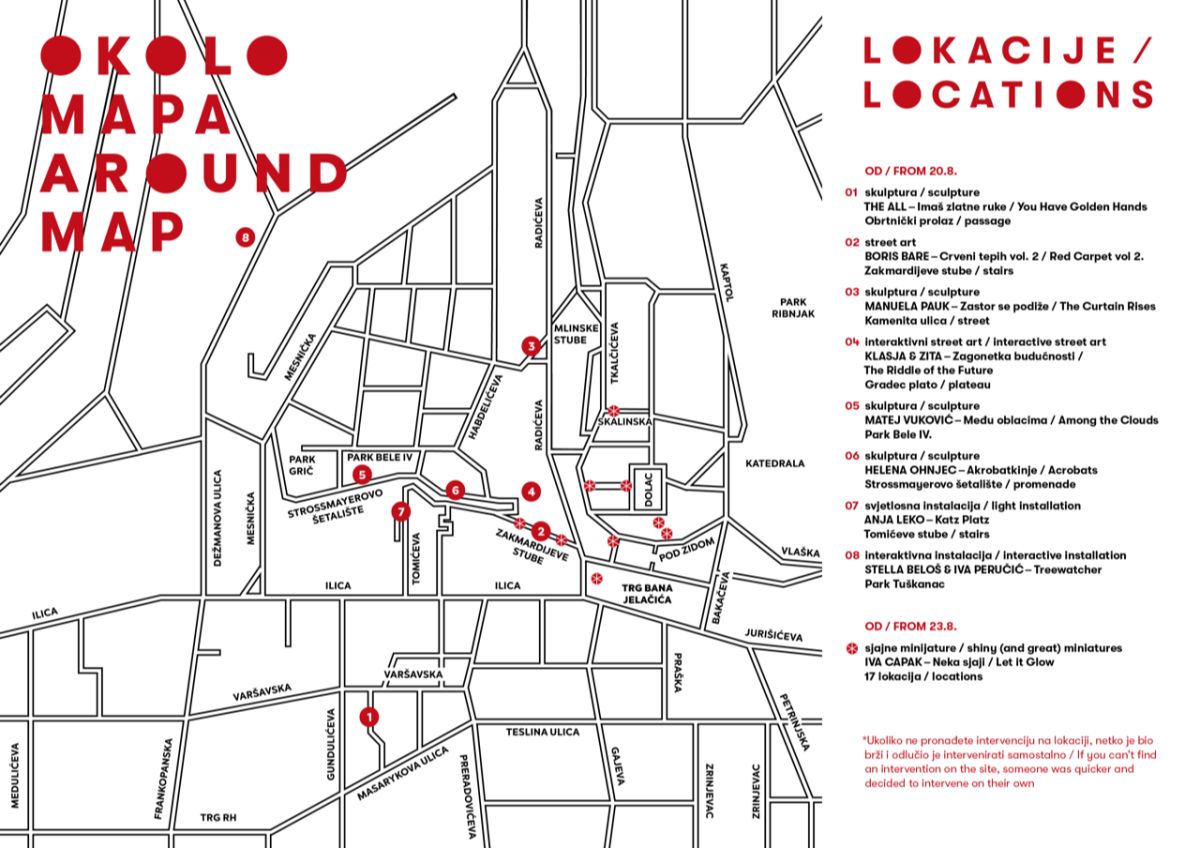
Zagreb Tourist Board
By placing art projects in the city landscape, "Okolo" revives public spaces and turns them into places where art spontaneously touches the city's everyday life. It highlights local artists and their personal experience and vision of the city while bringing contemporary art closer to a wider audience.
New artistic surprises include temporary space-specific installations and street art interventions that you can find "Around" around the city this year are signed by young sculptors Matej Vukovic and Manuela Pauk, multimedia artist Anja Leko, street artist Boris Bare, sculptor Helena Ohnjec, designer Iva Capak and design teams The All, klasja & zita and Stella Beloš and Iva Peručić.

Zlatne Ruke (''Golden hands''), The All
Start your artistic walk in the Craft Passage where you are symbolically greeted by golden hands (The All). On the way to the Upper Town, in the passage to Zakmardi's stairs, discover what the new-old Red Carpet (Boris Bare) looks like or what is hiding behind the curtain that is being raised (Manuela Pauk) in Kamenita Street. In the labyrinth on the Gradec plateau, solve the Riddle of the Future (ears & grains) and in the Bela IV Park. rest your head Among the clouds (Matej Vukovic). On Strossmayer's promenade, you meet Acrobats (Helena Ohnjec) who keep Matoš company, and on Katz Platz, in the passage by Tomić's stairs, you meet an unusual gang of cats (Anja Leko). At the very end of the tour, in Tuškanac Park, jump into the holiday net and become a Tree Observer. All the way, look carefully where you are walking and you may come across great miniatures by Ivo Capak that will adorn 17 mini locations.
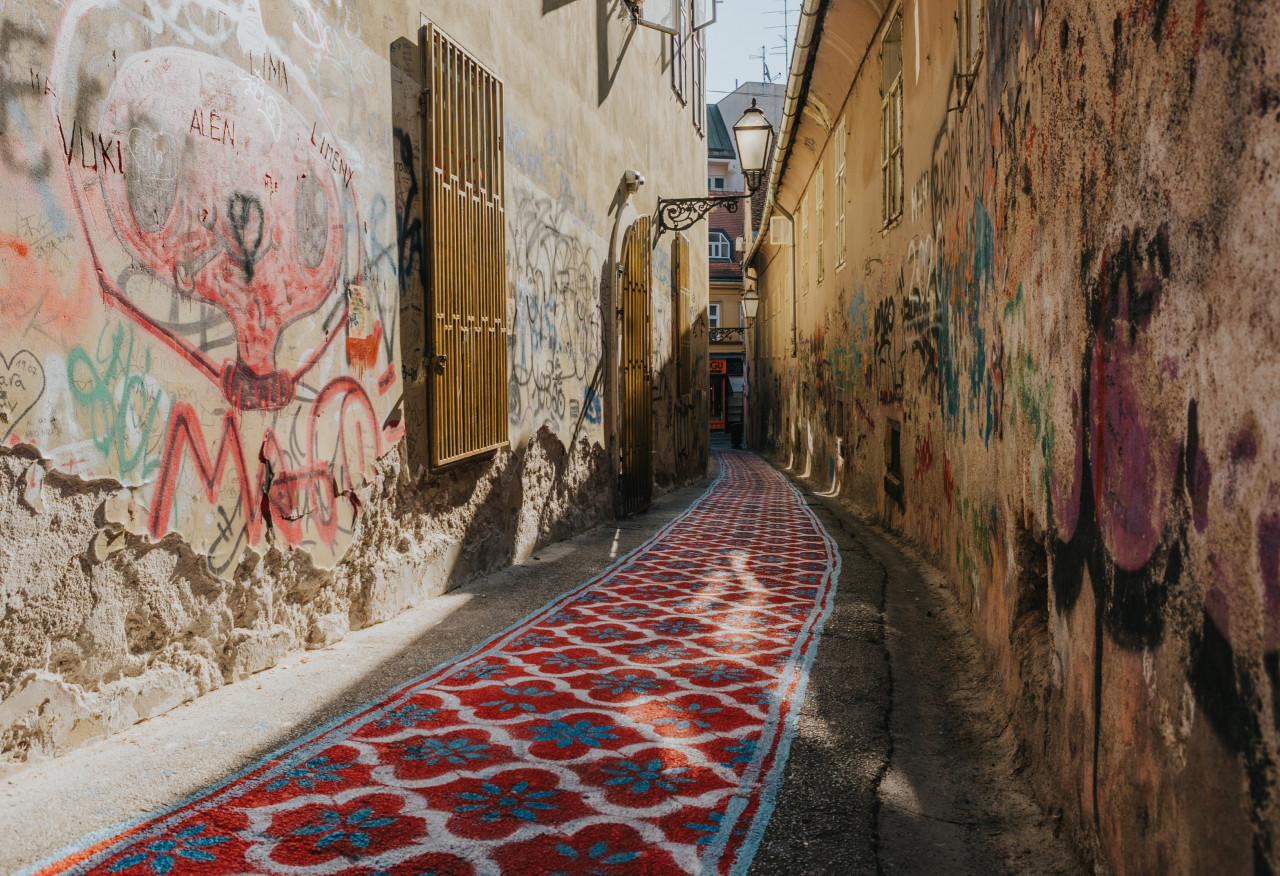
Crveni tepih (''Red carpet''), by Boris Bare
"Around" will be launched in 2018 by the Two of Us (Ana Mikin, Tina Kovačićek) in cooperation with the Zagreb Tourist Board. Singing forest in Bela IV Park, a woolen heart that became a symbol of Zagreb's recovery after the earthquake, red carpet to Gornji grad, silk sculpture in Tomićeva, large floor mural on the playground above Dubravka road, light installation in the canopy of Ribnjak park, godmother on the stairs Dolca, a sleeping giant in Petrinjska, cute street miniatures in play with urban elements and plants that play to the touch, these are just some of the interesting interventions with which "Okolo" has already enriched the streets of Zagreb and delighted citizens and tourists at the same time.
To learn more about the project ''Around'', visit the Zagreb Tourist Board dedicated page HERE.
For more information on what the Croatian capital has to offer, such as what to see or do, be sure to check out our Total Croatia guide, Zagreb in a Page 2021. Now in your language!
For more, make sure to check out our dedicated travel section.
Krapina-Zagorje County Becomes Part of ''Around Zagreb'' Campaign
August 19, 2021 - In addition to Zagreb County, the single destination campaign "Around Zagreb" has been extended to Krapina-Zagorje County in order to promote the diverse tourist and cultural offer on the outskirts of the Croatian capital.
After an excellent joint partnership between the Zagreb Tourist Board and the Zagreb County Tourist Board on a unique destination campaign, "Near the city, close to the heart" / "Around Zagreb", Zagreb Tourist Board this year expanded the campaign to promote Zagorje, reports HrTurizam.
The promotional campaign of the Zagreb Tourist Board "Close to the city, close to the heart" was expanded through cooperation with the Krapina-Zagorje County Tourist Board (TZKZŽ) and thus, for the first time, jointly promote Zagreb and Zagorje through a unique destination campaign with a focus on staying outdoors, in greenery and nature, and additional emphasis placed on the eno-gastronomic offer and historical heritage. The director of TZGZ (Zagreb Tourist Board), Martina Bienenfeld, pointed out that the cooperation with TZKZŽ is a logical step in upgrading the campaign "Close to the city, close to the heart".
“We have created a new visual, promotional film, as well as websites where we offer various itineraries and ideas for excursions that naturally connect Zagreb and Zagorje. So you can go on the Gastronomic Roads of Zagreb and Zagorje, experience 3 days of fun and relaxation, or look at the proposals for a fun and active weekend in Zagreb and Zagorje. There is also a new section, ''Did you know...'' which reveals that more than 75% of Zagreb covers green areas and that at least one of the 45 city parks is located in each neighborhood, as well as other attractions”, states Bienenfeld.
The head of the Tourist Board of Krapina-Zagorje County, Sanja Škrinjar, is also extremely satisfied with the first such cooperation and pointed out that the overlaps of the most important emitting markets for both destinations are certainly the starting point for the realization of such cooperation. ''We believe that we complement each other extremely well in creating an even better and richer offer for all future guests of our destinations with a tendency to extend their stay in Zagreb and Zagorje, especially since Zagorje "leans" on Zagreb and is a very good road connection between the two most important tourist destinations in the continental part of Croatia'', pointed out Škrinjar.
"TZGZ is launching the campaign in the markets of Austria, Bosnia and Herzegovina, Croatia, Germany, northern Italy, Slovenia, and Serbia, and all materials and websites are linguistically adapted to the markets we are addressing. With such facilities, we extend the stay of guests in both destinations'', concludes Bienenfeld.
The website www.aroundzagreb.hr offers creative suggestions on what to see and do, and there is also a promotional film that shows the natural, eno-gastronomic, sports, and historical offers of Zagreb and Zagorje.
Video in English, but with subtitles in four foreign languages (Croatian, Slovenian, English, and German) can be viewed and shared HERE.
Visit Total Croatia if you want to learn more about what Zagreb and Zagorje have to offer you. Now available in your language!
For more, make sure to check out our dedicated travel section.
How Far Can Zagreb Grič Cannon Fire? Ideal Conditions View of the Fire Range
July 21, 2021 - Ever wondered about the Zagreb Grič Cannon fire? TCN reporter Ivor Kruljac played with Google maps to provide an answer in ideal conditions.
While Zagreb Grič Cannon did not shoot at the time of writing this article, it is still one of the key symbols of Zagreb, and memories of its bang during midday is a vital part of the living in Zagreb experience.
As TCN previously wrote, the Grič Cannon was first introduced on January 1, 1877, and was located at the State's Meteorology department, back in the times when Croatia was part of the Austro-Hungarian Monarchy. It wasn't until 1927 that it was moved to Lotršćak, where it is situated to this day. In addition, the current cannon serving this purpose is actually the fifth to do the job and was donated to Zagreb by the Yugoslavian National Army (JNA), during Universiade.
Apart from signaling noon, the old legend says the Grič Cannon also served a defensive purpose. As TCN previously wrote, legend has it that the Ottoman commander Hasan Pasha (Hasan Paša) settled his army along the coast of the Sava river, in today's area of Novi Zagreb. He was preparing to cross the river and invade the city, but before that, he was about to have lunch, and Zagreb fired a cannon in the Ottomans' direction, close to Hasan, blasting a chicken he wanted to eat. The shot scared the hell out of the Ottomans, and they retreated, leaving Zagreb totally intact.
The legend itself is part of a book titled ''The Grič Cannon legend'' in which writer Dubravko Horvatić has gathered 20 Croatian legends, and the book is a mandatory book report title for Croatian pupils in the third year of elementary school.
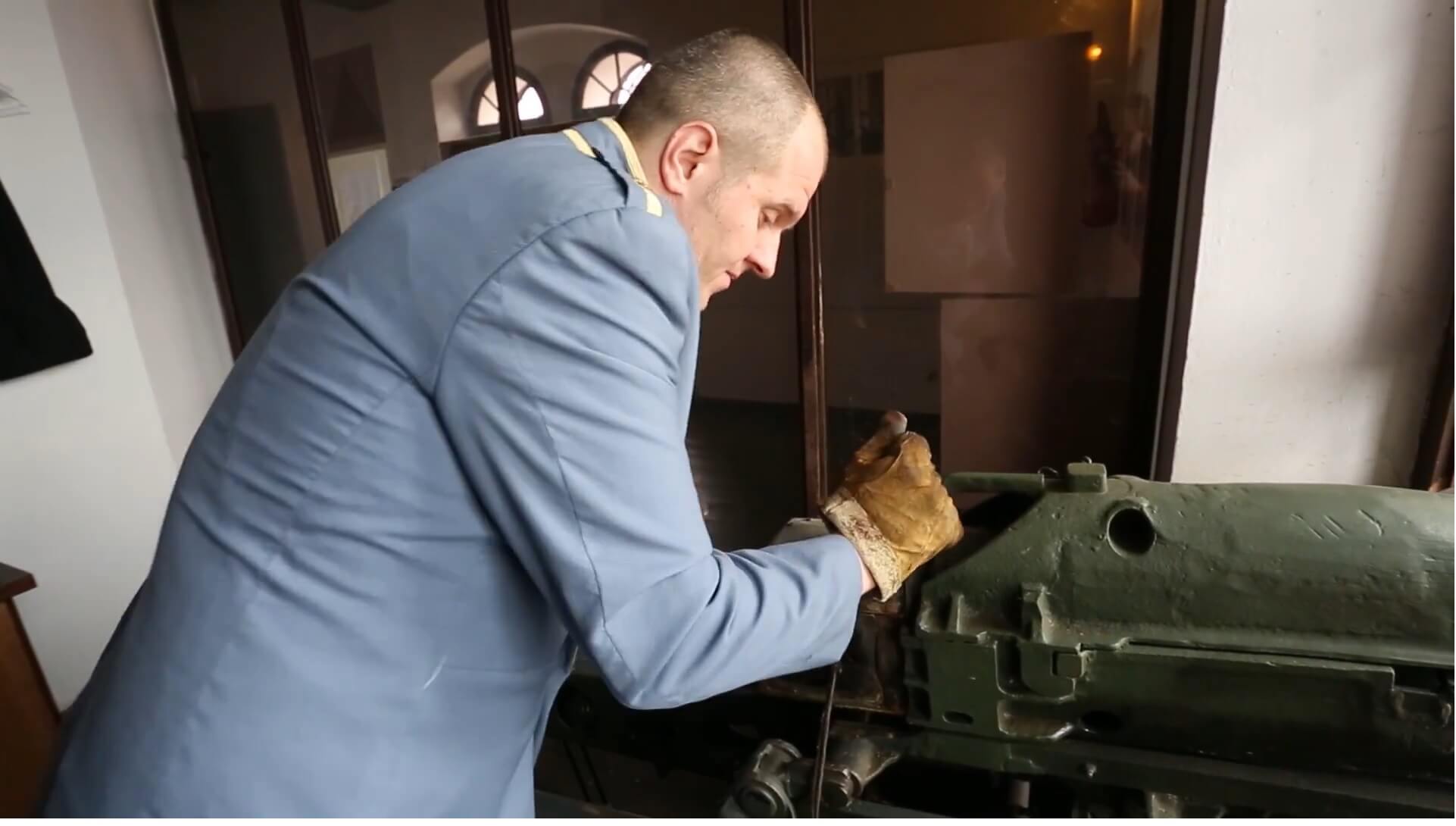 Preparing the cannon, screenshot / PIXSELL
Preparing the cannon, screenshot / PIXSELL
Legend vs facts
With the story taking place way back in the 16th century, it's obvious the tale is just a legend as the cannon wasn't introduced until the 19th century. Still, it's a cool story, and a bit of a twisted mind can't but help think: what's the range you could actually shoot with the Grič Cannon?
As the Wikipedia page says, and as a member of the Zagreb Tourist Board in Lotrščak tower confirmed to this sleuth reporter, the current cannon's range is 7,929 metres (almost eight kilometres), and the sound of the blast has a solid 140 dB.
Legend says Hasan Paša was on the coast of the Sava river, which means he was in southern Zagreb, and sure enough, the Grič cannon is facing south from Lotrščak. The cannon floor also has windows looking in each direction, meaning you could move the cannon to north, west, or east.
When playing with Google maps distance measuring tools, you can see that the smallest distance between the Sava river and Lotrščak is, give or take, about 3,1 kilometres. So, the current cannon, under the right angle, could easily make that shot.

The distance between Fort Lotrščak and Sava river, screenshot / Google Maps
Apart from the possibilities of buildings and hills messing up the shot, there are other things that need to be taken into consideration. As the Department of the Army U.S. Marine Corps identified back in 1996, in their manual, there are many factors that affect artillery fire.
Muzzle velocity, projectile weight, range wind, air temperature, air density, even the rotation of the Earth, not to mention the overall condition of the barrel, all of which are challenges that could limit the cannon's full potential. And yes, Google maps isn't really the most precise tool on the planet, but let's take a shot in the dark and see how far the Grič cannon could actually fire (keep in mind these projections are made solely based on the maximum range, and the factors aren't taken in account but are mentioned for the sake of trivia knowledge).
South! Aim! Fire!
Let's start from the cannon's current position. Assuming no buildings, hills, or anything else gets in the way, and you're a physics genius that managed to isolate yourself in Lotrščak with live ammo and achieve a clear straight shot, your cannonball makes an impact all the way in line with Donji Čehi (but a bit away to the east from that place). Donji Čehi, along with Gornji Čehi, used to be independent villages but are today part of the City of Zagreb. With only 1,72 km2 of length, the place is inhabited by 232 residents, based on a 2011 census.

Grič Cannon maximum range to the south, screenshot / Google Maps
West! Aim! Fire
Continue clockwise and set your cannon to take a shot towards the west, with a range of little under eight kilometres. You can score all the way to Krnska street in Gajnice. Krn is both a name of a mountain and a peak (2244) in neighbouring Slovenia. The mountain is a part of the Triglav National Park in Slovenia (and if this side note makes your attention turn to Slovenia, be sure to check our friends at Total Slovenia News). Gajnice is a neighbourhood in Zagreb that is inhabited by around 10,000 residents. The neighbourhood is notorious for its pretty lousy connection with the rest of the Zagreb, and local residents often complain about infrequent buses that connect them to Črnomerec from where they can travel to the city centre. Well, at least, the centre doesn't aim at them with a cannon.

Grič Cannon maximum range to the west, screenshot / Google Maps
North! Aim! Fire!
The new target, or perhaps better to say lucky shot, lies towards the north. Don't worry about Medvednica mountain getting in the way of a clear shot towards Zagorje, as the range isn't long enough. The shot will hit Medvednica mountain, more precisely, to the close proximity of Tusti Vrh. This location is 648 metres above sea level and serves as a stand for a communication station with some antenna polls. But, there's no need to shoot the place up and destroy a lovely piece of nature, which also serves as an important social role in regards to telecommunication. Instead, you can visit the place as the Gračani trail leads there.

Grič Cannon maximum range to the north, screenshot / Google Maps
East! Aim! Fire!
Finally, it's time to ruin someone's day in east Zagreb (fortunately, no person was hurt during these simulations in reality). Specifically, this applies to whoever lives in Retkovec III near Bruma Interijeri d.o.o., a company specialised in woodwork.
Petkovic is a neighbourhood that is part of the Dubrava district. It's mostly a residential place, like much of eastern neighbourhoods considered to be a bit of a rough area to live in. Still, things aren't as bad as they were as before.

Grič Cannon maximum range to the east, screenshot / Google Maps
Shooting blanks
Again, it's worth noting these projections aren't accurate science and imply conditions which are perfect. Of course, in an ideal world we wouldn't need firearms and everyone would be living in peace. In reality, where these ideal conditions don't apply, residents of the aforementioned areas, but also citizens in general, can be relaxed, as the ranges are irrelevant.
 Shots fired aftermath, screenshot / PIXSELL
Shots fired aftermath, screenshot / PIXSELL
''It's worth noting the cannon is modified, and it can't fire live ammo,'' warned the Zagreb TB official, who was a bit puzzled as to why I would even ask her for the potential range of a weapon overlooking the Croatian capital from Fort Lotrščak. But, as I'm sure any researcher will confirm, scientific curiosity often calls for asking controversial questions.
Learn more about Zagreb on our TC page.
For more about history in Croatia, follow TCN's dedicated page.
Zagreb Grič Cannon: Explosive Noon Reminder
July 9, 2021 - Zagreb Grič Cannon - a reminder of noon, and a reason to avoid the centre if you aren't a fan of loud sounds. Get your noise-canceling headphones and read about the cannon's history, courtesy of TCN reporter Ivor Kruljac.
If you find yourself walking around a wider Zagreb centre (such as Savska Cesta or Marin Držić Avenue) around noon, and you focus on the sounds of the city, you may notice a weird sound in between traffic and people passing. An unusual sound, as if someone dropped a heavy box. But, if around noon, you find yourself at Ban Jelačić square or upper town, you will hear a clear and loud BANG! Fear not, as this is not a terrorist attack, and you weren't lied to when your tourist agency swore to god Zagreb is safe from such horrors. The heart-stopping bang is a signifier of noon. If you hear a boom at 11:59 or 12:01, your watch is behind a minute. The cannon states that clear and very, very loud.
Loudest time checker you could think of
Grič cannon first started signaling noon on January 1, 1877, and was located at the State's Meteorology department, back in times when Croatia was part of the Austrian-Hungarian Monarchy. It wasn't until 1927 that it was moved to Fort Lotršćak where it is situated today.
According to the Klovićevi Dvori Gallery's official website, Fort Lotrščak was named after a bell and comes from campana latrunculorum, which is Latin for „Bell of Thieves“ that rang before closing city gates. Historians aren't exactly sure what the Fort looked like in medieval times, although it is speculated based on old sketches that it had only two floors. It wasn't until 1857 that romanticistic architecture gave the fortress today's four floors and an additional tower at the very top (from which you have a breath-taking view of Zagreb today).

Fort Lotrščak © Ivor Kruljac / Total Croatia News
In the 17th century, the Fort served as trading storage and had various other ways to adapt to the need of Zagreb and Zagreb's citizens at different times. At one point, when the City was out of money to restore and repair the Fort, it gave Lotrščak to citizens for rent. Citizens who wanted the Fort also had the obligation of maintaining it, and in case of enemy assault, it was to be returned back to the City for defense purposes.
Warning shot
Speaking of defense purposes, an old legend says how this cannon managed to save Zagreb with a single shot from the Ottoman conquerors. Legend has it that the Ottoman commander Hasan Pasha (Hasan Paša) settled his army at the coast of the Sava river, in today's area of Novi Zagreb. He was preparing to cross the river and invade the city. But before that, he was about to have lunch one day, and Zagreb fired from the cannon in the Ottoman's direction, close to Hasan and blasting a chicken he wanted to eat. The shot scared the hell out of the Ottomans and they retreated, leaving Zagreb intact.
Changing arsenal
Over the course of time, there were five different Grič cannons that served the purpose of signaling noon. The current canon was given during Zagreb's Univerzijada in 1987, courtesy of the Yugoslavian National Army (JNA) as Croatia at the time was part of the Socialist Federal Republic of Yugoslavia (SFRJ).
As for the first three, you can find them today in the collection of the Zagreb City Museum. The first cannon originated in 1876 and was replaced by the second cannon in the unidentified year at the end of the 19th century. The third cannon you can see in Zagreb City Museum, and the first that was situated on Lotrščak fort, was introduced in 1928, and it was made by restoring a Polish cannon from 1912.
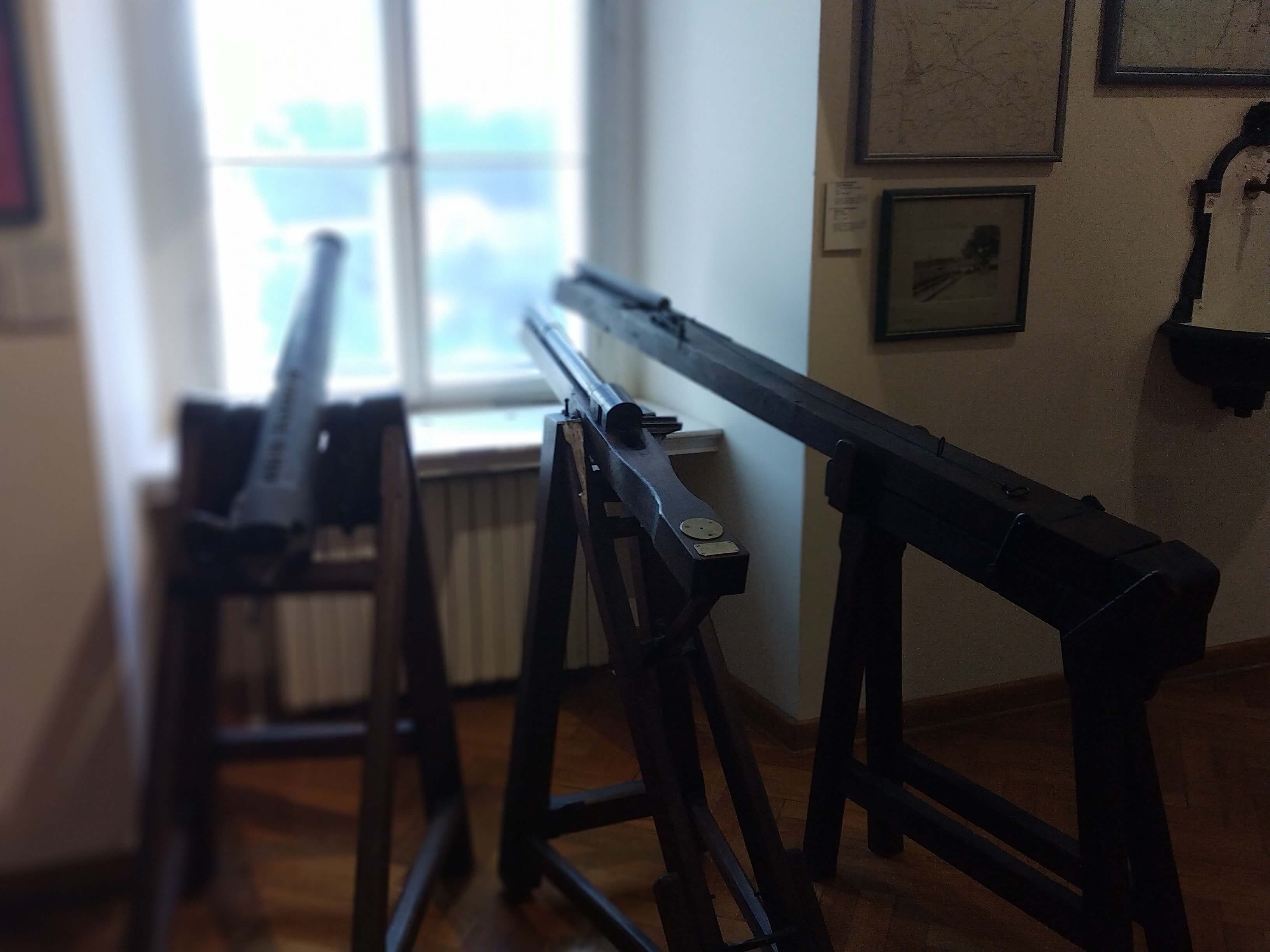
Three cannons showcased at Zagreb City Museum © Ivor Kruljac / Total Croatia News
So finding yourself in front of Fort Lotrščak (whose entrance is located right next to the Upper town funicular station) is not recognizable if you are not a fan of loud noise as it can give you a sound fright even down below at Jelačić square and the surrounding area. But, for the brave ones, the Grič cannon can provide a unique souvenir from Zagreb. It doesn't use live ammo (the cannon is modified so it can't), but it does fire several pieces of thick cardboard that then flies down to the area underneath Lotrščak's entrance and smelling like gunpowder.
Ceased fire
Despite being a regular background sound for the experience of living in Zagreb, Grič cannon went through periods when it ceased fire and stopped making statements. The first such instance was World War I and then followed by the war in the nineties. Most recently, the cannon was silenced after the Zagreb earthquake on March 22, 2020, but it re-fired hot and heavy sometimes in May 2020. However, followed by the December 29th Petrinja earthquake, which was also felt heavy in Zagreb, the cannon is silent even today.
„We are not quite sure when it will re-fire“, briefly commented the Zagreb Tourist Board member that welcomed me in Fort Lotrščak, one of the locations where Zagreb TB has a regular stand. Still, despite the cannon being silenced, you can climb and sightsee Lotrščak, the famous cannon as well as the watchtower on top of the Fort, for the prize of 20 kunas.

One of the exhibitions at Lotrščak © Kula Lotrščak
The Lotrščak Fort address is Tomićeva 9, and the Fort occasionally also hosts various exhibitions at times too. But, the cannon is a regular feature, and there are lots of info on the history of the cannon and the Fort itself there too on the walls- both in English and Croatian.
Learn more about Zagreb on our TC page.
For more about history in Croatia, follow TCN's dedicated page.
5th Day of Zagreb Digital Nomad Week and Beginning of Ambassador Program
June 26, 2021 - A look at the 5th day of Zagreb Digital Nomad Week and the first digital nomad ambassador!
The announcement of Veronica Mulhall as the ambassador of 'Zagreb Digital Nomads' concluded the fifth day of 'Digital Nomad Week' on Friday, where the organizers Saltwater Nomads, Total Croatia News, and the Zagreb Tourist Board presented the advantages, opportunities, and possibilities of the Croatian capital for remote digital nomad work, reports Jutarnji List.
In July, Veronica Mulhall will be the first ambassador - a digital nomad who will work and live in Zagreb for a month.

"Congratulations to Veronica on this election, Zagreb welcomes her, and I think she will have a wonderful time in our city; that is, she will have great opportunities to find her new job office here. We will introduce her to everything that Zagreb has to offer digital nomads," said Petra Maršić Buljan from the Zagreb Tourist Board.
The 'Zagreb Digital Nomads' ambassador was preceded by three 'Digital Nomad Week' panels which analyzed future trends in the labor market, digital nomads as a solution to changes in the labor market, and Croatian policies in accepting and deepening global trends in teleworking.
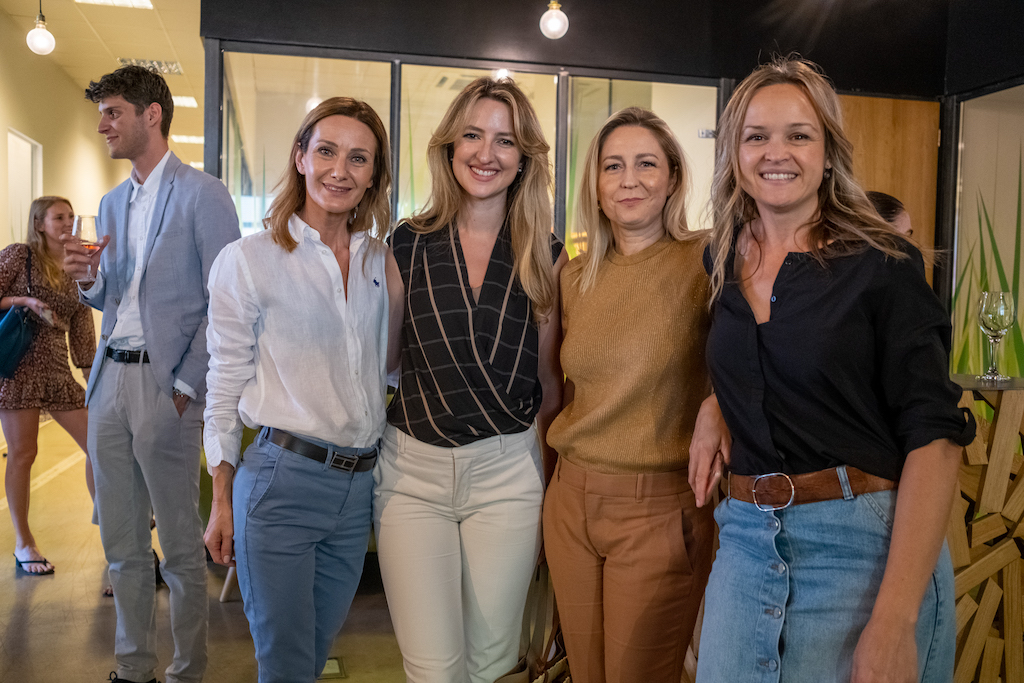
Jose Alfonso Kusijanović
Before the panels, the participants were given a lecture by blogger and labor market researcher Albert Canigueral on the future of work.
"The future of work has three dimensions, the future of the job itself, the job and the fulfillment of business tasks or goals. Nomads are one of the solutions for the future of the workplace, and how far we have come in applying this way of working is evidenced, among other things, by the example of employers in the Swedish transport business who are committed to regulating the work of truck drivers from home," said Canigueral. He recalled the thesis of the famous sociologist Peter Drucker that the basic question of the labor market is not to find answers to the demands that arise but to ask a key question of the labor market.
After Canigueral’s presentation, the first three panels of the ‘Digital Nomad Week’ closing day entitled ‘Sustainable and Self-Renewing Destinations’ followed. In addition to moderations by Ron Tardiff, the director of the Zagreb Tourist Board Martina Bienenfeld, the director of the Dubrovnik Tourist Board Ana Hrnić, the author of numerous travelogues Anja Mutić, and the entrepreneur in tourism Daniel Lacko spoke about sustainable and self-renewing tourist destinations.

Ron Tardiff, one of the winners of the last Dubrovnik Digital Nomads in Residence competition, discussed Sustainable and Regenerative Destinations with a panel that included Martina Bienenfeld, CEO of the Zagreb Tourist Board. (Jose Alfonso Kusijanović)
Ana Hrnić pointed out that the tourist season in the pearl of Croatian tourism in Dubrovnik is currently under the strong influence of last year's consequences of the coronavirus and large restrictions in air traffic on Dubrovnik tourism, which, she warned, is an air destination. On the other hand, the Dubrovnik Tourist Board director pointed out that 2019 was a record year in terms of visiting guests for Dubrovnik tourism.
"In 2019, we took the first steps to ensure the long-term sustainability of Dubrovnik tourism, limiting the number of cruiser arrivals in the city port," said Ana Hrnić. Martina Bienenfeld reminded that the Zagreb tourist offer in 2020, in addition to COVID-19 and lockdown, also faced a devastating earthquake.
"I must emphasize that we have not given up our efforts to prove that we are still 'alive' as a tourist destination, and we have done many great projects and campaigns since the beginning of the pandemic. I want to remind you that Zagreb changed, and we do not give up with new stories, new projects, highlighting some of the projects such as Pimp my Pump, Mali Zagreb and Triptych. When it comes to the sustainability of the city's tourist offer, we try to prove that Zagreb is not only the capital of a beautiful tourist country but a great place to live and work," said Martina Bienenfeld.
 Tanja Polegubić, organizer of Zagreb Digital Nomad Week, moderated a panel consisting of Petra Maršić Buljan from the Zagreb Tourist Board, Paul Bradbury from Total Croatia News, Dalibor Kovačević from Raiffeisen Bank Hrvatska, and Matthew Parsons from Skift. The theme was Future of Work Trends and Croatia's Global Standing. (Jose Alfonso Kusijanović)
Tanja Polegubić, organizer of Zagreb Digital Nomad Week, moderated a panel consisting of Petra Maršić Buljan from the Zagreb Tourist Board, Paul Bradbury from Total Croatia News, Dalibor Kovačević from Raiffeisen Bank Hrvatska, and Matthew Parsons from Skift. The theme was Future of Work Trends and Croatia's Global Standing. (Jose Alfonso Kusijanović)
The first panel was followed by a conversation between the moderator of ‘Digital Nomad Week’ Michael Freer, and Mandy Fransz, the founder of the company ‘Digital Leap’ for Digital Transformation.
"I heard about Croatia as a digital nomad destination, came here, and was convinced that Croatia provides a lot of events, but also opportunities for community development, which I consider the most important part of my job," said Mandy Fransz.
In the second panel, moderated by Tanja Polegubić from Saltwater Nomads, Petra Maršić Buljan from the Zagreb Tourist Board, Paul Bradbury, CEO of Total Croatia News, editor of the Skift portal Matthew Parsons and Dalibor Kovačević from Raiffeisenbank. This was followed by a presentation by Dean Kuchel, who introduced himself to the participants as a nomadic lifestyle ambassador.

Jan de Jong (Digital Nomads Association), Nikolina Pejović (Hrvatski Telekom) and Tanja Polegubić (Saltwater Nomads). (Jose Alfonso Kusijanović)
The last panel of the fifth day featured Jan de Jong, an entrepreneur who initiated the digital nomad visa in Croatia, Kristina Grbavac from the auditing company KPMG, Branka Bajt Hrvatski Telekom, and Hermes Arriaga Sierra from Impact Hub.
Asked by panel moderator Michael Freer how he came up with the idea to initiate the introduction of digital nomad visas in our country, Jan de Jong said that at his first participation in a conference on Croatian tourism, he faced the question of how to make Croatia a year-round tourist destination. The answer to the latter question, Jan de Jong, as he said, was given in the texts of Paul Bradbury on the portal Total Croatia News.

In the third and final panel, moderated by Michael Greer, Branka Bajt from Hrvatski Telekom, Kristina Grbavac from KPMG, Jan de Jong from DNA Croatia, and Hermes Arriaga Sierra from Impact Hub discussed about DNA Croatia, Policy, and Connecting a Global Community. (Jose Alfonso Kusijanović)
"In Paul’s texts, three words shone on me, digital nomad tourism. Then I started to promote this concept in my public speeches, finding great support from the followers of my speeches, but, very soon after, almost all major media in the country," said de Jong, revealing that after they received support for the development of digital nomad tourism from the Croatian Government, i.e., the Office of the Prime Minister. We managed, de Jong, concluded that Croatia becomes one of the top ten countries in the world with a visa for digital nomads. De Jong continues to implement his idea through the DNA Croatia association.

Paul Bradbury, Total Croatia News CEO, talks to Dean Kuchel, who spoke about Community Building, and Israel's Ambassador to Croatia, Ilan Mor. (Jose Alfonso Kusijanović)
"One of the DNA Croatia association goals is to extend the visa from the current six-month residence permit for digital nomads. We also want to simplify the procedures regarding the taxation of digital nomads," announced Jan de Jong.
Meet one of Friday's keynote speakers, Albert Cañigueral, one of the Dubrovnik nomads-in-residence and recently appointed to lead the Catalan Government's Transparency and Open Data, division. Albert will be focusing on the topic of the day, the future of work.
Tourist Board Director Martina Bienenfeld on Zagreb Digital Nomad Week, Ryanair, Tourism in Pandemic
For the latest news and features on digital nomads in Croatia, check out the dedicated TCN section.
Successful Tourist Board Synergy: Around Zagreb Promotes Capital and Surroundings
June 22, 2021 - The Zagreb Tourist Board and the Zagreb County Tourist Board are again cooperating in promoting Zagreb and its surroundings through a unique destination campaign - Near the city, Near the heart / Around Zagreb.
Near the City, Near the Heart is a joint promotional campaign created to develop a year-round platform to promote the rich offer of the capital and its surroundings, reports HRTurizam.
In this sense, as a destination campaign, it addresses key markets, promoting the outdoors, greenery, and nature with a focus on health and sustainability, and raising awareness of Zagreb and its surroundings as a desirable environment and tourist destination.
This year's edition of the campaign introduces certain novelties, and they are presented in more detail by the director of the Tourist Board, Martina Bienenfeld: “The success of the campaign so far has prompted us to improve our platform and present it to key markets. So - with a refreshed visual and itineraries - we created a new section, 'Did you know?' which presents interesting things from our environment. We are now launching the campaign in the markets of Austria, Bosnia and Herzegovina, Croatia, Slovenia, Serbia, and Germany, and we will soon expand it through cooperation with Krapina-Zagorje County."
"The campaign will be conducted online through advertorials and banners for a month. Advertorials will be adapted linguistically for each individual market and will present a rich cultural offer, with a focus on living in greenery, recreation, and sustainable tourism, all through interesting stories that present the current offer of Zagreb and its ring," explains Darja Dragoje from TZGZ.
In the last two years, the cooperation between these two tourist boards has grown into a whole series of campaigns and concrete tourist products that the guests of the capital can enjoy. The profession also recognized the partnership cooperation of these tourist boards as an example of cooperation in the field that brings very concrete results to all stakeholders.
The Zagreb County Tourist Board director, Ivana Alilović, says: "Domestic and foreign tourists do not think about administrative borders, but about the content. Precisely for this reason, the cooperation between the tourist boards of Zagreb and Zagreb County was logical. I am delighted that the director of Binenfield recognized the great potential of Zagreb County because Zagreb and the ring together are stronger. We have combined urban and rural, and with health and cultural tourism, rich outdoor content, and authentic enogastro offer, we have made this destination even more attractive. The enogastro service will focus on the new campaign, which with new visuals tells a new story of a metropolis and its surroundings, which complement each other with quality and rounded tourist products. With such facilities, we extend the stay of guests in both destinations."
The entire offer is united on aroundzagreb.hr, and information is currently available in Croatian, English, German and Slovenian.
For more, follow our travel section.
20 Tourists in Zagreb Tested For COVID-19
ZAGREB, 13 April, 2021 - Foreign tourists who generate at least one bed night in Zagreb can be tested for COVID-19 at 50% of the price and about 20 have already been tested over the weekend, the director of the Zagreb Tourist Board (TZGZ), Martina Bienenfeld, said on Tuesday.
TZGZ is the first regional tourist board in Croatia that has opened a testing station for foreign tourists as had previously been proposed by Tourism and Sports Minister Nikolina Brnjac.
Testing to be co-financed
In addition to opening the testing station, TZGZ has decided to cofinance testing that is conducted during weekends and public holidays, Bienenfeld told Hina.
TZGZ will cover half the cost of testing for tourists, she said, estimating that the greatest demand will be in the coming period and that that will depend on the percentage of inoculated tourists from the countries they are coming from, but also of employees in tourism and citizens themselves, and finally on the introduction of Digital Green Certificates at the EU level.
Testing during weekdays will be at the normal price and already about ten Zagreb hotels are providing testing services. Testing can also be conducted at Zagreb's airport.
Providing opportunity for tourists to extend their stay
"One of the important reasons why we decided to co-finance testing in the days noted is that this provides the opportunity for tourists to extend their stay in Zagreb, because they do not have to worry where and when they can be tested when returning to their countries and they can avoid quarantine," said Bienefeld.
All the necessary information regarding testing is available at www.infozagreb.hr/korona-virus in various languages, she said and added that the first tourists tested this way last weekend (10 and 11 April) were from Italy, Denmark, Germany and Albania.
Bienefeld said that since the beginning of the year until 11 April, almost 65,000 tourists had visited Zagreb and they generated 177,500 bed nights, which is about 47% of arrivals and 58% of bed nights generated in the comparable period in 2020.
Compared to the record 2019 year, that is about 27% and 37% of arrivals and bed nights respectively.
For more about COVID-19 in Croatia, follow TCN's dedicated page.
Development of Health Tourism: High Priority for Croatian Tourist Offer
March 25, 2021 - Both the Croatian Ministry of Tourism and Sports and Croatian tourist boards recognised the development of health tourism as a high priority for Croatia.
To discuss the development of health tourism in Croatia, a branch that is becoming one of the more important Croatian tourist products, Croatian Tourism and Sports minister Nikolina Brnjac met with Kvarner Tourist Board director Irena Peršić Živadinov, Kvarner Health Tourism cluster president Vladimir Možetič, and Zagreb Tourist Board director Martina Bienenfeld. As life expectancy and healthy lifestyle trends increase, the value of health tourism grows. The novel coronavirus only made that growth even more rapid.
"Over 80,000 tourists in 2020 visited Kvarner (well-known for Lošinj Island and its hospital for respiratory issues) for health services. Today, many people are recovering from the consequences of the novel coronavirus there," said the Kvarner Tourist Board director Živadinov.
"We have all the advantages for further development of health tourism: a good reputation of health services, qualified staff, natural richness of thermal sources, good climate, and long tradition of tourism," said minister Brnjac. Her goal is to pull Croatia out of the perception of a country only good for the summer season.
Croatia offers health services in wellness and medicine tourism. Health tourism is most associated with the regions of Kvarner, Istria, northern Croatia, and Zagreb, but the goal is to include other regions that have the potential for health tourism and to achieve the goals of a strategy that needs to be accomplished by 2030.
Martina Bienenfeld said that the Zagreb Tourist Board is working on the City's recognition as the centre of medical excellence. She pointed out good traffic connections, a mixture of the Mediterranean and mid-Europe climate, as well as good prices of health services as great advantages of Croatia's capital to the international clientele.
The Health Care Bill and Services in Tourism Bill now allow hospitality and health tourism services in hospitals and medical centres. These legal changes are also significant in attracting further investments in the field.
For more about travel in Croatia, follow TCN's dedicated page.
Zagreb in Chinese Lonely Planet: Museums, Art, Parks Presented to China
March 13, 2021 – On the other side of the world, Croatia's capital is well-known as the "city of museums," which is precisely how the author Si Ma Yan presented Zagreb in Chinese Lonely Planet's article.
The Chinese edition of Lonely Planet, one of the most influential world tourist guides, published a guide about Zagreb in its March edition. As reported by Franka Gulin, Croatian National Tourist Board director in China, the guide nicely and vividly brings all the information about Zagreb and is primarily intended for culture, art, and local food lovers.
"Although the realization of tourist trips from distant countries is significantly difficult in these circumstances, publishing a guide about Zagreb maintains visibility and promotion of our capital in China, but also Croatia as a whole," said Croatian National Tourist Board director Kristjan Staničić.
Namely, travelers from China immensely appreciate recognizable Croatia's tourist products, such as culture, nature, and eno-gastronomy.
As Zagreb is known in China as a "city of museums," the guide's author Si Ma Yan emphasizes museums, galleries, murals, facades, and other street art forms on Zagreb's streets. The author also recommends visiting interesting antique shops and buying antique jewelry in numerous retro vintage shops and charming jewelry workshops. When it comes to accommodation, options are proposed for different categories of travelers, from the luxury segment to travelers on a smaller budget. The guide especially emphasizes that Zagreb is ideal for walks in beautiful parks, and Croatia is also famous as a filming destination.
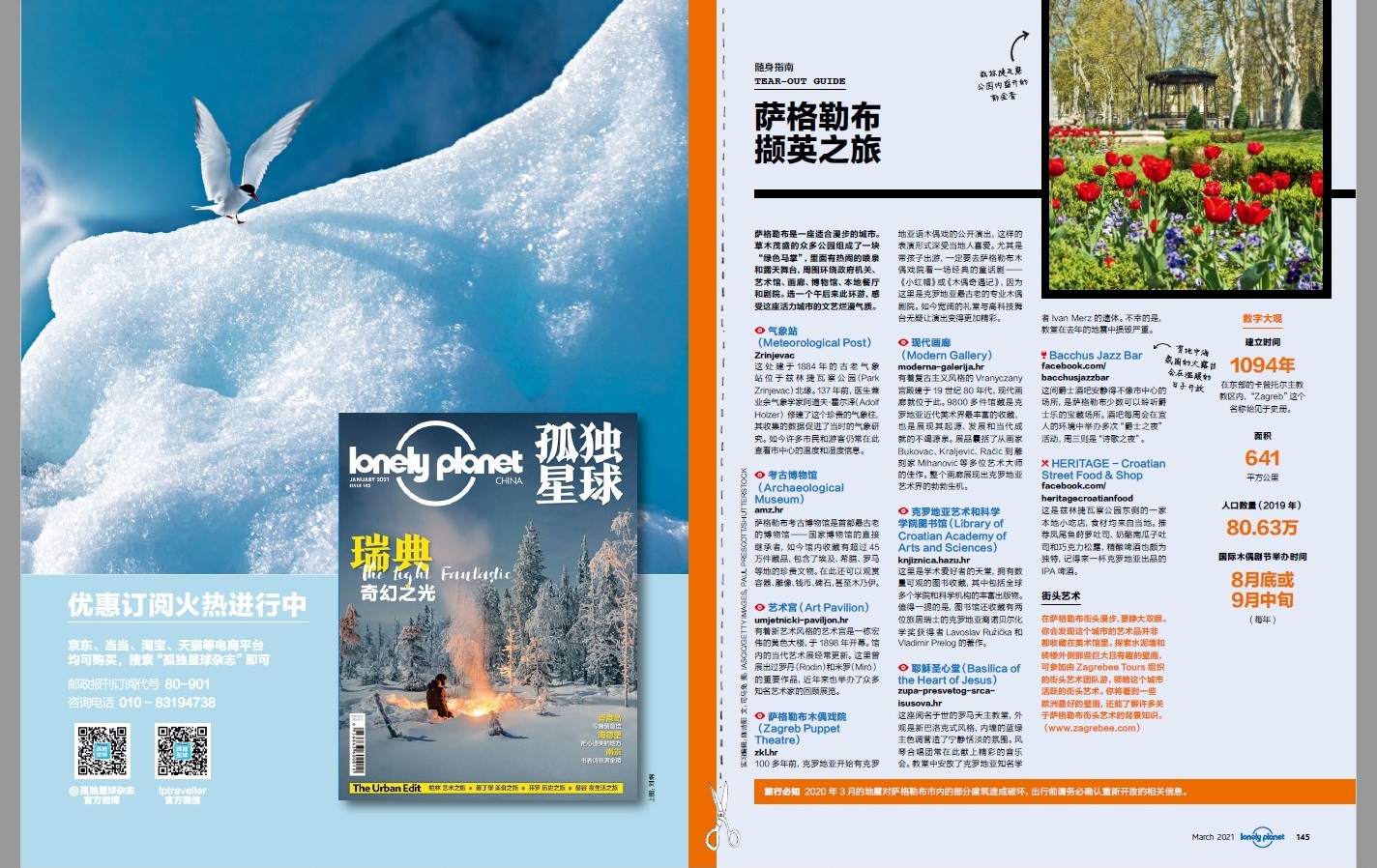
Zagreb in Chinese Lonely Planet / Source: Croatian National Tourist Board
"After Lonely Planet declared Zagreb the Best in Europe in 2017, this is the second major recognition for our city by this world-renowned tourist guide. We are honored that Zagreb was presented to the Chinese market through a mini urban guide. We hope that, despite the demanding times, it will contribute to the additional positioning of our capital in the Chinese market. Guests from China have always been important for Zagreb, and publishing such an urban guide confirms how important the Croatian capital is in China," said the Zagreb Tourist Board director Martina Bienenfeld.
Besides, Franka Gulin, together with the Croatian Ambassador to China Dari Mihelin, paid an official visit to the Chinese province of Chongqing, where they met with representatives of departments and business entities for culture and tourism. Chongqing Municipality is one of China's fastest-growing regions in economy, culture, and tourism, with a population of about 40 million. Their airport in pre-COVID times was well connected to all the leading airports around the world, and the area was in constant growth in outbound travel.
For the latest travel info, bookmark our main travel info article, which is updated daily.
Read the Croatian Travel Update in your language - now available in 24 languages.
Zagreb In Top Three European Capitals With Cleanest Tourist Accommodation
January 23, 2021 – According to user ratings of the most important platforms for booking accommodation, Booking.com, Airbnb, and Tripadvisor, Zagreb is among the three best European destinations with the cleanest tourist accommodation.
Namely, with the onset of the pandemic, the requirements for travel hygiene have further increased. Therefore, a survey on the European metropolises with the cleanest accommodation was recently conducted. Zagreb Tourist Board reports that some guests described their stay in the Croatian capital as "brilliantly clean" and "spotlessly clean."
The survey was published by the British portal ShowersToYou.co.uk and is based on the average ratings of accommodation's cleanliness in famous European capitals.
In the overall ranking of the 20 cleanest destinations in Europe, Zagreb took a high third place with an average rating of 4,74. Only Lisbon, with an average rating of 4,792, and Prague, with an almost identical rating as Zagreb - 4,741, are ahead of the Croatian capital.
Considering only the ratings of Booking.com and Airbnb users, Zagreb takes first place, ahead of Moscow, Lisbon, Prague, Vienna, and other capitals. In case only Tripadvisor users' ratings are taken into account, Zagreb is in 14th place, but this does not diminish its overall ranking given the average ratings on all three platforms, where Zagreb is in third place.
"We are extremely pleased with this result. Hygiene has become especially important, and the health aspects of staying in a destination have become one of the main backbones when promoting in the foreign tourism market. We are pleased with Airbnb, Booking.com, and Tripadvisor platforms' user ratings. They give additional value to Zagreb as a safe and clean destination," said the Zagreb Tourist Board director, Martina Bienenfeld, congratulating Zagreb accommodation providers.
In addition to the mentioned survey, Zagreb won a valuable award at the online BH Tourism Film Festival 2020 in Sarajevo. Namely, Zagreb Tourist Board won the award for "The Best Culture and Heritage" for the film "Zagreb Loves You."
This film is an unusual tourist promotional film because it was made in March last year when two misfortunes hit Zagreb at once – a pandemic and an earthquake. The film has become the backbone of the comprehensive #ZagrebLovesYou campaign, and this is Zagreb Tourist Board's fifth award for it in a little over half a year.
For the latest travel info, bookmark our main travel info article, which is updated daily.
Read the Croatian Travel Update in your language - now available in 24 languages.


